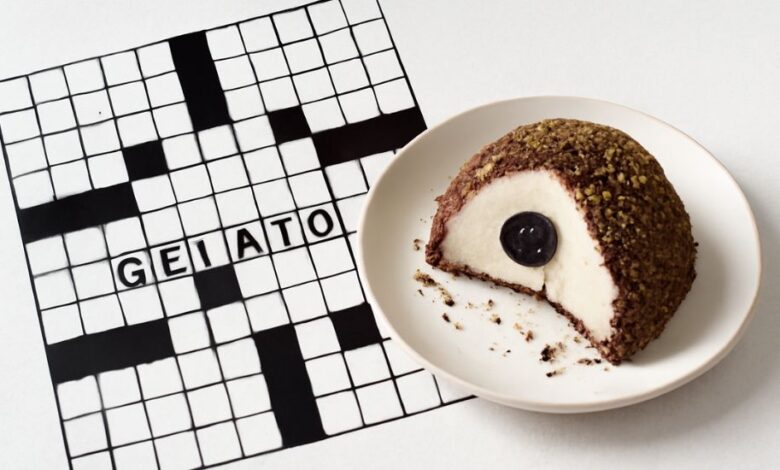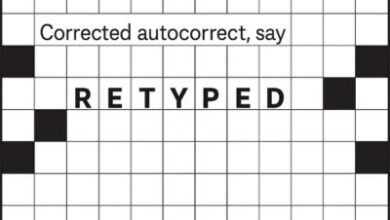Tartufo Ingredient Crossword: Why GELATO Is Always the Answer

Crossword clues often draw inspiration from unexpected corners of culture — from literature and history to cuisine. One of the most intriguing food-related clues to appear in major puzzles is “Tartufo ingredient.” It’s a clever, elegant hint that often leaves solvers both hungry and puzzled. The answer? GELATO.
While seemingly simple, this clue bridges two worlds: the art of puzzle construction and the traditions of Italian dessert-making. To understand why “gelato” is the perfect answer, we’ll explore the culinary background of tartufo, the reasoning behind crossword clue design, and the enduring popularity of this particular pairing.
What Exactly Is “Tartufo”?
A Name with Two Meanings
In Italian, tartufo means “truffle.” In culinary terms, it can refer either to the prized underground fungus or, more deliciously, to a frozen dessert. When used in crossword puzzles, it almost always points to the dessert rather than the fungus.
The Dessert’s Origin
The tartufo dessert was born in Pizzo, a small coastal town in Calabria, southern Italy. Local legend says that in the early 1950s, a gelato-maker named Giuseppe De Maria, affectionately known as Don Pippo, was preparing frozen desserts for a wedding banquet. When he ran out of molds, he improvised — shaping the gelato by hand, pressing two flavors together with a melted-chocolate center, rolling it in cocoa powder, and freezing it.
The result was a round, truffle-like ball of gelato, christened tartufo because of its resemblance to the earthy delicacy. That spur-of-the-moment creation became an Italian icon, still celebrated today as Tartufo di Pizzo.
The Anatomy of a Classic Tartufo
A traditional tartufo is composed of several distinct layers:
- Gelato Base – Usually two flavors, such as chocolate and hazelnut, though other combinations like pistachio or vanilla are common.
- Core Filling – A soft center of molten chocolate, fruit syrup, or frozen fruit (like cherries or raspberries).
- Outer Coating – A dusting of cocoa powder, a hard chocolate shell, or chopped nuts.
Everything starts and ends with gelato — the essential building block and the reason “Tartufo ingredient” leads crossword enthusiasts straight to this word.
Why GELATO Is the Perfect Crossword Answer
The Logic Behind the Clue
Crossword clues typically contain two key components: the definition and the wordplay. In the clue “Tartufo ingredient,” the word “ingredient” signals that the answer must be a component of tartufo, not the dish itself.
Once solvers recall that tartufo is an Italian dessert made primarily from gelato, the answer becomes obvious. “Gelato” fits perfectly — both linguistically and logically.
Letter Count and Simplicity
Most published crosswords list the number of letters for each answer. “Tartufo ingredient (6)” narrows the possibilities considerably. Common dessert ingredients like “cream” (5 letters) or “sugar” (5 letters) won’t fit, but “gelato” does. That makes it a fair, solvable clue while still testing the solver’s culinary knowledge.
A Consistent Puzzle Staple
Over the years, “Tartufo ingredient” has appeared in several well-known puzzles, including major daily crosswords. In nearly every case, the solution has been GELATO. This consistency reinforces the association in crossword databases and solver memory banks, making it a familiar clue for seasoned puzzlers.
Gelato: The Heart of Italian Frozen Desserts
More Than Just Ice Cream
Though often compared to ice cream, gelato is distinct in both texture and composition. Italian gelato typically contains less fat, less air, and a denser texture than American ice cream. It is churned at a slower speed and served slightly warmer, creating a velvety consistency and richer flavor.
When puzzle creators use “gelato” as an answer, they’re referencing not just an ingredient but a cultural symbol of Italian craftsmanship.
Regional Variations
Just as Italian cuisine varies from region to region, so too does gelato. In northern Italy, creamier, milk-based gelatos dominate; in the south, fruit-forward and nut-flavored varieties take precedence. The tartufo of Calabria blends both traditions, often using hazelnut and chocolate gelato with a fruity or liqueur-based center.
A Dessert with Personality
The tartufo isn’t simply “ice cream in disguise.” It’s a sculpted, handmade treat with layers of flavor and texture. That’s why the crossword clue works so beautifully: it connects the artistry of dessert-making with the creativity of crossword construction.
How “Tartufo Ingredient” Became a Crossword Favorite
A Foodie’s Delight in Puzzles
Crossword editors often sprinkle their grids with culinary references — they appeal to a wide range of solvers. Food clues like “Italian dessert,” “pasta variety,” or “coffee drink” evoke familiar, sensory associations that make puzzles more engaging.
“Tartufo ingredient” fits perfectly in this category. It’s exotic enough to feel clever but well-known enough to be solvable. The word “gelato” also provides a clean combination of vowels and consonants that crossword constructors love to use.
Educational Value
Puzzles often serve as a subtle form of education. A solver who didn’t know what tartufo was before encountering the clue may look it up afterward — learning not only about Italian desserts but also about gelato’s distinction from regular ice cream. This dual role of entertainment and learning is part of what keeps crossword culture thriving.
Analyzing the Clue Linguistically
The Definition Component
In this case, “ingredient” acts as the definition. It tells you the answer must be something that goes into tartufo.
The Indirect Hint
“Tartufo” is the indirect hint that limits your possible answers. Even if a solver doesn’t immediately know what tartufo is, the foreign-sounding name suggests Italian cuisine. Therefore, possible ingredients are likely Italian or dessert-related — gelato, espresso, zabaglione, mascarpone, etc. Among these, only gelato perfectly matches the letter count and the dessert context.
Cultural Resonance
The clue’s charm also lies in its cultural resonance. It invokes Italian elegance, culinary tradition, and the artistry of handmade desserts — all in a single word. Crossword enthusiasts appreciate that balance of sophistication and solvability.
Beyond the Grid: The Story of Tartufo di Pizzo
The Birthplace Legend
In the town square of Pizzo stands a plaque honoring the invention of tartufo. Local gelaterias proudly advertise Tartufo di Pizzo Originale. Tourists can sample the authentic version — a ball of chocolate and hazelnut gelato hiding a molten-chocolate center, coated in cocoa powder. It’s served simply, without garnish, because the dessert itself is pure perfection.
The Craft of the Gelatiere
Making tartufo is an art. Skilled gelatieri (gelato makers) layer the flavors by hand, ensuring the perfect balance between creamy texture and contrasting fillings. The handmade element gives tartufo its rustic, authentic charm — much like a crossword grid filled in by hand gives satisfaction to solvers.
A Symbol of Italian Pride
Over time, tartufo became a culinary emblem of Calabria, celebrated in festivals and food fairs. It even holds a protected status as a traditional Italian product. That cultural importance enriches its role in crosswords — transforming a six-letter answer into a miniature history lesson.
Tips for Crossword Solvers
Recognizing Food Clues
When you see a clue referencing an Italian or French term, check for context words like “ingredient,” “dish,” “dessert,” or “entrée.” These typically narrow the domain to cuisine.
For instance:
- Tiramisu component → MASCARPONE
- Pesto ingredient → BASIL
- Tartufo ingredient → GELATO
Recognizing these patterns helps solvers quickly connect the dots between cultural references and language hints.
Watching for Enumeration
Enumeration — the number of letters in the answer — is a crucial guide. “Tartufo ingredient (6)” should trigger you to think of six-letter food terms related to Italy. “Gelato” immediately fits, while longer or shorter options do not.
Cross-Checking Letters
If you already have partial letters filled in, the pattern _E_LA_O almost always resolves to GELATO. Using crossing clues can confirm your hypothesis quickly.
Avoiding Red Herrings
New solvers sometimes mistake “tartufo” for the truffle fungus used in savory dishes. While that’s correct in another context, crossword editors almost always use the dessert meaning when the word “ingredient” appears. Savory interpretations are rare exceptions.
Thematic Crosswords and Food Clues
In themed puzzles, food terms often tie into broader motifs — “Sweet Treats,” “Frozen Favorites,” or “Italian Indulgence.” Within those themes, clues like “Tartufo ingredient” contribute both linguistic and cultural richness.
Constructors use them to:
- Diversify vocabulary in the grid.
- Provide approachable clues amid more difficult ones.
- Celebrate culinary culture in a playful way.
Food-based clues also humanize crosswords. They remind solvers that puzzles aren’t just about language; they’re about life’s experiences — eating, traveling, learning.
The Interplay of Taste and Wordplay
The best crossword clues evoke sensory imagery. “Tartufo ingredient” conjures flavor, texture, and nostalgia. It reminds solvers of holidays in Italy or café desserts shared with friends.
That sensory connection makes the clue memorable. When “gelato” finally clicks into place, the solver experiences a small moment of delight — similar to tasting the dessert itself.
How “GELATO” Performs in Crossword Grids
From a construction standpoint, GELATO is a wonderful word:
- Starts with a strong consonant (G) and ends with a vowel (O), balancing well with crossing entries.
- Contains alternating consonants and vowels, making it grid-friendly.
- Evokes a positive, universally recognized image.
Crossword creators love such words — they’re aesthetically pleasing and easy to slot into multiple grids without forcing awkward fill.
A Broader Look at Italian Cuisine in Crosswords
Italian food words appear frequently in puzzles because they’re familiar to English-speaking audiences yet maintain an exotic flair. Consider how often you’ve seen clues like:
- “Espresso foam” → CREMA
- “Pasta type” → PENNE or RIGATONI
- “Tiramisu layer” → COCOA
- “Tartufo ingredient” → GELATO
These clues make crosswords more flavorful — literally and figuratively. They celebrate Italy’s culinary influence while giving solvers little moments of recognition.
Cultural Echoes: From Italy to the Puzzle Page
The journey of tartufo from a Calabrian kitchen to an English-language crossword exemplifies cultural exchange. It shows how ideas, flavors, and words travel — from the hands of an Italian gelato-maker to the minds of crossword enthusiasts around the world.
This interconnection is part of what makes puzzles so rewarding. Every clue is a story, every answer a discovery. “Tartufo ingredient” tells a story of creativity, improvisation, and sweetness — both in dessert and in wordplay.
Modern Interpretations of Tartufo
Contemporary chefs have taken tartufo to new heights. Some serve it with white chocolate shells (tartufo bianco), others stuff it with fruit purees or liqueur fillings. Vegan and dairy-free versions now exist, using plant-based gelato and nut milks.
Despite these innovations, one thing remains constant: gelato is always the foundation. Whether made from traditional dairy or modern alternatives, it defines the texture and spirit of tartufo.
The Relationship Between Food Memory and Puzzle Memory
Psychologists note that memory is strengthened by emotional and sensory cues. That’s why food-based crossword clues often stick in people’s minds. You may forget a clue about a river in Latvia, but you’ll likely remember “Tartufo ingredient.”
Each time you encounter it, you recall the creamy texture of gelato or the joy of solving a tricky puzzle — a small fusion of pleasure and intellect.
Why Write About This Clue?
For bloggers, educators, and crossword enthusiasts, dissecting clues like “Tartufo ingredient” provides content that bridges multiple audiences. It’s part culinary exploration, part puzzle commentary. Articles on such topics perform well because they:
- Appeal to food lovers and puzzle solvers alike.
- Offer practical solving tips.
- Deliver cultural trivia in an accessible format.
- Enrich SEO with unique keywords like tartufo, gelato, crossword, and Italian dessert.
Writing and SEO Strategy Notes
When crafting your own article or blog entry about “Tartufo ingredient crossword,” remember:
- Keep the keyword prominent — Use “tartufo ingredient crossword” naturally in headings and introduction.
- Add depth — Don’t just provide the answer; explain the background.
- Maintain reader engagement — Use stories, fun facts, and clear examples.
- Provide value — Include tips for solvers or trivia for food enthusiasts.
- Conclude with authority — Summarize what readers have learned.
This approach satisfies both human readers and search algorithms — ensuring visibility, shareability, and engagement.
Conclusion
When a crossword asks for the “Tartufo ingredient,” the six-letter answer GELATO connects two worlds: Italian dessert culture and the art of puzzling. It’s more than just a word — it’s a symbol of creativity, history, and the joy of discovery.
The story of tartufo reminds us that some of the world’s best inventions are accidents born from necessity. The story of its crossword clue reminds us that even small words can hold rich layers of meaning.
So the next time you fill in those six letters — G-E-L-A-T-O — picture a small Italian town, a bowl of creamy dessert, and the satisfying click of a crossword answer falling into place.
This detailed exploration of “Tartufo ingredient crossword” is brought to you by Newsta — your source for stories that mix culture, language, and curiosity.



